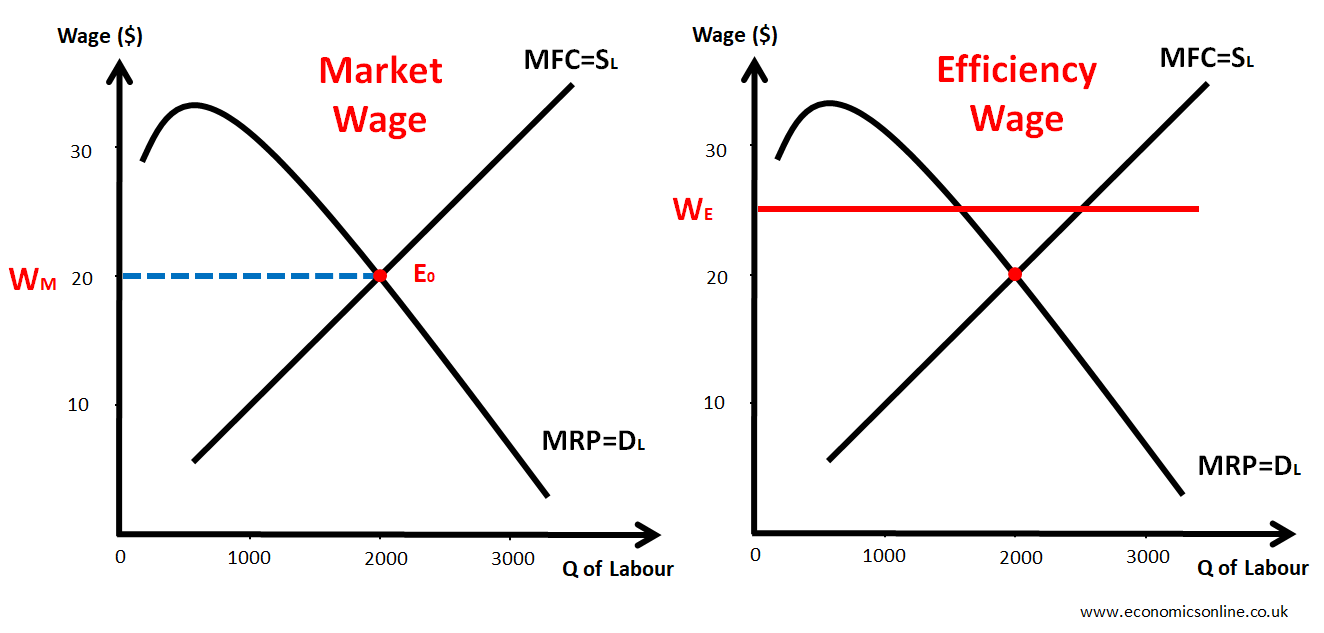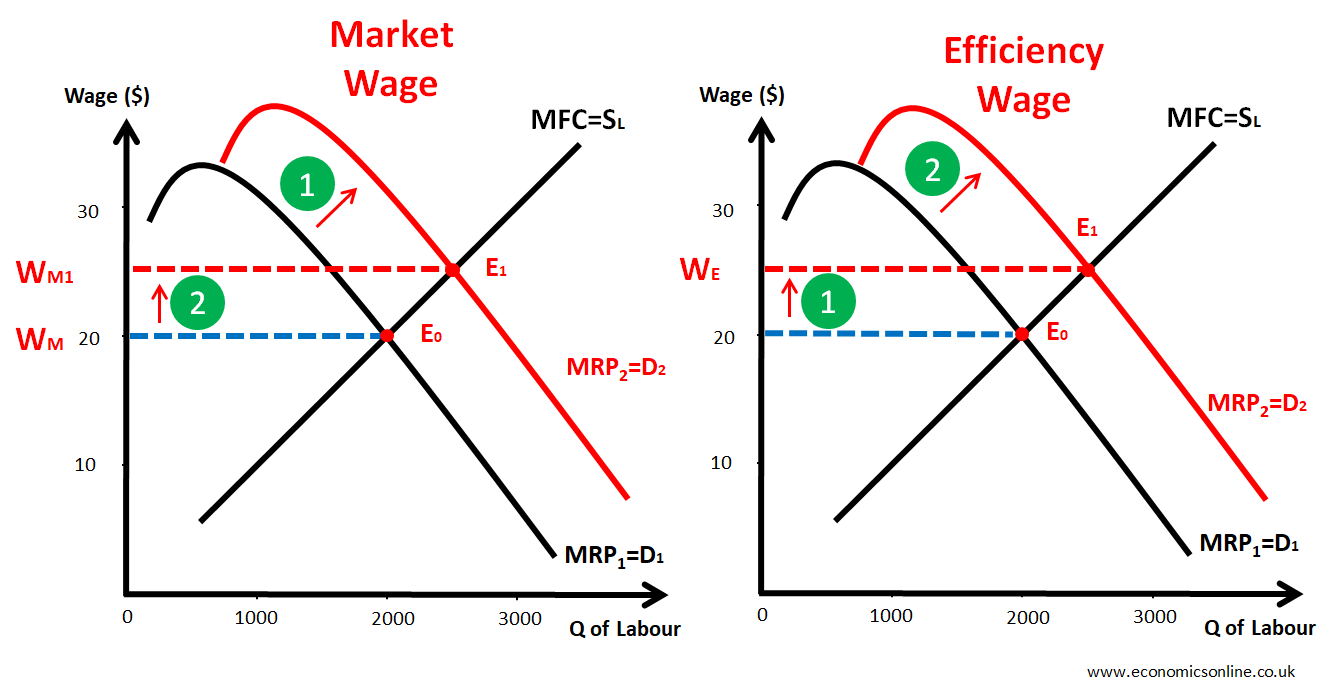
An image showing a person chasing money.
Efficiency Wage Theory
What is the Efficiency Wage Theory?
The efficiency wage theory states that paying workers higher wages than the market rate can increase their productivity, which can lead to greater efficiency and profitability in the long run.
The efficiency wage hypothesis states that if workers are paid more than the market rate, they will be motivated to work harder, produce more output, and be less likely to leave their jobs. The cost reduction due to higher productivity will outweigh the cost increase of paying above average wages, which will increase the profitability of the firms.
Origin of the Efficiency Wage Theory
The efficiency wage theory has its roots in the work of economist Alfred Marshall, who first proposed the idea of a "fair wage" in the late 19th century. Marshall argued that workers should be paid a wage that is sufficient to meet their basic needs, including food, housing, and clothing. He believed that paying workers a fair wage would lead to greater efficiency and productivity in the workplace, as workers would be more motivated to work hard and produce high-quality work.
In 1984, the economists George Akerlof and Janet Yellen argued that paying workers more than the market wage rate could lead to a more productive and efficient workforce. They suggested that higher wages could help reduce turnover, increase job satisfaction, and improve the quality of work produced by employees.
Understanding the Efficiency Wage Theory
In order to better understand this theory, let's first define some basic terms.
Wage
A wage is a monetary payment that an employer pays to an employee in exchange for their physical or mental services. It is usually expressed as an hourly rate or a fixed amount per week or month. In labor economics, wage is a critical component of the labor market and is used to attract and retain workers as well as incentivize high levels of productivity and performance.
Efficiency Wage
Efficiency wages are the level of wages that are higher than the market wage and the minimum wage and are paid by employers to improve the productivity of their workforce.
Market Wage vs. Efficiency Wage
Let’s understand the difference between the market wage and the efficiency wage with the help of the following diagram:

The above diagram shows two graphs. The graph on the left shows the determination of market wage according to the traditional labour market model. The market wage (WM), $20, is the equilibrium wage paid at the market-clearing level according to the marginal revenue product of workers.
The graph on the right shows the efficiency wage (WE). The efficiency wage of $25 is set above the market wage.
Now consider the following diagram:

The graph on the left illustrates the traditional model having assumption that the market wage is a function of productivity and that higher productivity of workers will shift the MRP curve upwards (1) and hence the market wage will increase from WM to WM1 (2).
On the other hand, the graph on the right illustrates the efficiency wage theory, which assumes that productivity is a function of the wage and that paying workers the efficiency wage (higher than the market wage) (1) will increase workers’ productivity, and as a result, the MRP curve will shift upwards (2).
In order to determine the optimal efficiency wage, employers must consider the marginal cost of increasing wages and weigh it against the marginal benefit of the improved productivity that comes with the wage increase.
By paying higher wages than the market rate, employers are able to attract and retain higher-quality workers who are more motivated to perform well. Additionally, efficiency wages can serve as a form of insurance against shirking or poor performance by employees, as the higher wage acts as a motivator for workers to work harder and maintain their employment status.
Why should Firms Pay Efficiency Wages?
The main principle behind offering higher wages is increasing workers' output. Let’s look at some important reasons for paying efficiency wages.
Minimizing Labour Turnover
Paying efficiency wages can reduce employee turnover. Firms bear the recruitment and training costs of workers, and they don’t want them to leave their jobs. Paying efficiency wages can achieve this objective of making workers motivated and loyal. Moreover, low labor turnover also means that the firms have to devote less time and resources for searching, hiring and training new workers.
Reducing Shirking: The Shirking Model
Shirking refers to employees evading their tasks, which might be due to a lack of motivation. The shrinking model by Joseph Stiglitz, suggests that when employees are paid higher wages, they become more invested in keeping their job since they have more to lose if they are laid off. According to Shapiro and Stiglitz, workers who receive higher wages will be more committed to their job and put in a higher level of effort without shirking. However, this efficiency wage should be higher than the market wage.
Boosting Morale
Firms have another incentive to pay an efficient wage. If firms pay higher wages to workers in return, according to the theory of reciprocity, employees are psychologically motivated to exhibit greater effort leading to better job performance.
Trust and Loyalty
If efficiency wages are paid to workers, they feel more valued and become loyal and trustworthy. In specific industries, trust and employee loyalty go beyond holding on to a job. For example, in the jewellery industry, the pay is usually high, as firms have to minimise the chances of theft.
Recruitment of Skilled Candidates
The efficiency wage can attract a vast pool of talented and eligible candidates. This allows the management to choose the best candidates among them.
Health and Nutrition
Some nutritional theories suggest that paying efficiency wages to workers can lead to an improvement in their nutritional intake and, in turn, an increase in worker effort. This will make the workers healthy and fit, which is essential to increasing labor productivity. However, this is not the primary reason that firms offer efficiency wages and is only applicable in certain cases.
Advantages of Efficiency Wage
There are several advantages associated with the efficiency wage.
Higher Productivity and Efficiency
Paying workers high wages can lead to a more productive and efficient workforce. When workers are paid more, they tend to be more satisfied with their jobs, which can lead to lower turnover rates and reduced costs associated with recruiting and training new employees.
Higher Quality of Work
Paying the efficiency wage can lead to improved quality of work. When workers are paid more, they may be more motivated to produce high-quality work, which can lead to increased customer satisfaction and loyalty.
Less Negative Effects
Lower wages can have negative effects, including higher government assistance, theft in firms, and an increased crime rate. By paying workers higher wages, employers can help reduce these negative effects and contribute to a more stable and prosperous society.
Disadvantages of Efficiency Wage
Despite its advantages, the efficiency wage theory is not without its drawbacks.
Higher Cost
The first disadvantage of the efficiency wage is that it can lead to higher costs for employers. When employers pay workers more than the market wage rate, it can increase their labour costs and reduce their profitability, at least in the short run.
Wage Inflation
Another disadvantage of the efficiency wage theory is that it can lead to wage inflation. If all employers in a particular industry start paying workers higher wages, it can lead to an increase in the market wage rate, which can lead to wage inflation.
Monopsony
Some believe that the firms with the monopsony power in the labor market have no need to pay efficency wage because workers don't have other employers to have jobs with.
Monitoring Cost
Monitoring is an essential aspect of the efficiency wage theory. To ensure that workers are putting in the effort required to justify their higher wages, employers need to monitor their work. This can be costly.
Involuntary Unemployment
A widespread payment of efficiency wages can cause involuntary unemployment in the labor force and ultimately negate the benefits of paying higher wages in the first place.
Examples of Efficiency Wage Theory
Companies like Costco and Trader Joe's are known for paying their workers higher wages than their competitors, which has led to lower turnover rates, higher productivity, and increased customer loyalty. In fact, a study by the Harvard Business Review found that Costco's high-wage strategy had led to a 90% employee retention rate, compared to just 50–60% for its competitors.
Ford Motors is another example of a company that implemented efficiency wages. In 1914, Henry Ford doubled the wages of his workers to $5 a day. The higher wages helped reduce employee turnover and attract a more skilled workforce. The decision to pay higher wages contributed to increasing productivity and helped establish Ford Motors as a leading company in the automotive industry.
Conclusion
In conclusion, the efficiency wage theory is an important concept in economics that proposes that paying workers a higher salary than the market rate can lead to greater efficiency and productivity in the workplace. While the theory is not without its drawbacks, it has been successfully implemented by many companies and governments around the world. Ultimately, the efficiency wage theory provides an interesting and potentially powerful approach to managing the workforce that should be carefully considered by employers and policymakers alike.


